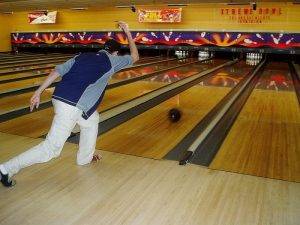Bowling, a sport that combines precision, skill, and camaraderie, offers a unique experience for enthusiasts of all ages. Whether you’re a seasoned bowler aiming for a perfect game or a newcomer eager to learn the ropes, the presence of bumpers on the lanes can significantly influence your bowling experience. In this in-depth exploration, we unravel the nuances of bowling bumpers—those resilient guards that line the edges of the lane. From their role in gameplay to their impact on scores and strategies, we delve into the world of bowling with bumpers.
Bowling Bumpers: An Introduction
Purpose and Function
Guardrails for Novices:
Bowling bumpers, also known as guardrails or simply “bumpers,” are raised rails that run along the edges of bowling lanes. Their primary purpose is to prevent the ball from veering into the gutters, providing support for novice bowlers, especially children.
Automatic Adjustment:
Modern bowling centers often feature automated bumper systems. When activated for specific players, the bumpers automatically rise to create a barrier that guides the ball toward the pins. For advanced players or during league play, bumpers can be selectively raised or lowered based on individual preferences.
Bumper Materials and Construction
Resilient Materials:
Bumpers are typically made of a resilient material such as rubber or foam. This construction allows the bumpers to absorb the impact of the bowling ball, preventing damage to the ball and the lane.
Secure Attachment:
Bumpers are securely attached to the sides of the lane, forming a continuous guardrail. They can be easily raised or lowered by the bowling center’s automated system or manually by staff.
Bumpers and Scoring: A Tactical Consideration
Impact on Scores
Novice Advantage:
For novice bowlers, especially children or those new to the game, bumpers offer a significant advantage. By preventing gutter balls, bumpers increase the likelihood of hitting pins, resulting in higher scores and a more enjoyable experience.
Strategic Considerations:
While bumpers can boost scores for beginners, they also introduce strategic considerations. Skilled bowlers may choose to play without bumpers to employ advanced techniques, such as hook shots and precise pin targeting.
Score Recording with Bumpers
Specialized Scoring:
When bumpers are in use, some bowling centers implement a specialized scoring system. The scoring takes into account the presence of bumpers and adjusts the scoring parameters accordingly.
Tracking Strikes and Spares:
Bumpers can influence the outcome of strikes and spares. A well-placed shot with bumpers in use may result in pins being knocked down indirectly, affecting the score calculation.
Bumpers in Family and Recreational Bowling
Family-Friendly Bowling
Inclusive Experience:
Bumpers make bowling more inclusive, especially for families with young children. They create an environment where everyone, regardless of age or skill level, can participate and enjoy the game.
Reduced Frustration:
For children or those new to bowling, the presence of bumpers reduces frustration by ensuring that the ball stays on the lane and gives them a sense of accomplishment with each roll.
Recreational Play
Casual and Social Atmosphere:
Recreational bowling centers often use bumpers to create a casual and social atmosphere. Whether it’s a friendly gathering or a corporate event, bumpers encourage participation and make the game accessible to all attendees.
Mixed-Skill Groups:
In groups with mixed bowling skill levels, bumpers level the playing field, allowing everyone to have a good time without concerns about individual abilities.
Advanced Techniques with Bumpers
Hook Shots and Spin
Strategic Bumper Use:
While bumpers are typically associated with novice play, skilled bowlers can strategically use bumpers to execute hook shots. By angling the ball toward the bumpers and allowing it to rebound, players can create angular trajectories for precise pin targeting.
Spin Techniques:
Bumpers provide an opportunity for advanced spin techniques. Skilled bowlers can use the bumper rebound to add spin to the ball, influencing its path and increasing the chances of striking specific pins.
Precision and Pin Placement
Targeted Pin Placement:
Advanced players may experiment with using bumpers to influence the placement of pins. By strategically bouncing the ball off the bumpers, bowlers can aim for specific pin configurations, enhancing their strategic approach.
Skillful Maneuvering:
Using the rebound effect of the bumpers requires skillful maneuvering. Players must understand the angles, ball speed, and spin required to achieve the desired outcome.
Bumpers in Bowling Leagues and Tournaments
League Considerations
Varied Skill Levels:
Bowling leagues often consist of participants with varying skill levels. Some leagues may choose to use bumpers to ensure an inclusive and enjoyable experience for all members.
Special Events:
Certain league events or themed nights may incorporate the use of bumpers to add an element of fun and challenge. This can break the routine and create a lighthearted atmosphere.
Tournament Dynamics
Competitive Considerations:
In professional bowling tournaments, the use of bumpers is not standard practice. Tournaments are conducted on lanes without bumpers to emphasize skill, precision, and the true test of a bowler’s ability.
Standardized Conditions:
Tournament play typically adheres to standardized lane conditions, and the absence of bumpers ensures a level playing field for all participants.
Maintenance and Safety Considerations
Lane and Bumper Maintenance
Regular Inspections:
Bowling centers conduct regular inspections of both lanes and bumpers. This includes checking for wear and tear, ensuring secure attachment, and addressing any issues promptly.
Automated Systems:
Modern bowling centers with automated bumper systems invest in regular maintenance to keep the systems functioning optimally. This includes software updates, sensor calibration, and mechanical checks.
Safety Measures
Player Safety:
Bumper systems are designed with player safety in mind. The materials used are chosen for their shock-absorbing properties, minimizing the risk of injury in case of accidental contact.
User-Friendly Controls:
Bowling centers provide user-friendly controls for raising and lowering bumpers, ensuring that staff and players can operate them safely.
The Future of Bowling Bumpers: Technological Advancements
Enhanced Automation
Smart Bumper Systems:
Advancements in technology may lead to smart bumper systems that can dynamically adjust based on a player’s skill level. These systems could incorporate artificial intelligence to provide personalized experiences.
Interactive Features
Gamification Elements:
Future bowling experiences may include interactive features where bumpers become part of a gamified setting. This could add an extra layer of excitement to the game, especially for younger players.
Related Post:
Navigating the Game Clock: The Dynamics of How Many Periods in Basketball
Mastering the Court: A Comprehensive Guide to Basic Skills in Volleyball
The Defensive Canvas: A Deep Dive into Strategic Defensive Positions in Football
In the intricate world of bowling, bumpers stand as versatile allies. They serve as guardians for newcomers, enablers of strategic play for advanced bowlers, and facilitators of inclusive and enjoyable experiences for all. Whether you’re aiming for a perfect game, introducing someone to the joy of bowling, or participating in a friendly league, the presence of bumpers adds a dynamic element to the game.
As bowling technology continues to evolve, so too may the role of bumpers. From automated systems to interactive features, the future promises exciting possibilities. However, one thing remains constant—the enduring appeal of bowling with bumpers as a sport that welcomes all, where the clatter of pins and the cheers of players create a symphony of shared moments on the lanes.







